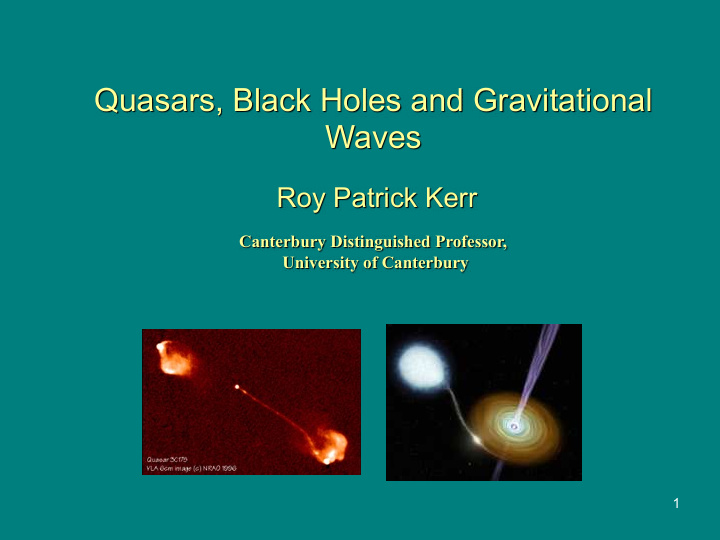



Quasars, Black Holes and Gravitational Waves Roy Patrick Kerr Canterbury Distinguished Professor, University of Canterbury 1
Michelson-Morley Experiment (1887)
The Schwarzschild Solution Within a year of Einstein proposing his theory, Professor Karl Schwarzschild constructed a metric that was to be the most important solution of Einstein’s equations for the next 40+ years. It gave the gravitational field outside a non-rotating sphere. This mathematical solution has a problem where the factor in brackets is zero, This is called the event horizon. At first people thought that matter could not go through this surface, neither in nor out.
Eddington Coordinates In 1924 Sir Arthur Eddington invented a new coordinate system which solved this problem. 1882-1944 He showed that there is still something very strange happening at the event horizon.
“Black Holes” • A spaceship can approach as close as it likes to this surface and still escape from the gravitational field, but if it ventures inside the event horizon then there is no return. The gravitational field is so strong that the spaceship is drawn rapidly to the center. It is in a “Black Hole”. • If the Sun and the Earth were to collapse to black holes then the radii of their event horizons would be 3km and 1cm respectively. • The density of the Sun as it collapsed inside its event horizon is 20,000,000,000,000 kg per cubic centimeter, denser than a Neutron star. • The Sun is 300,000 time heavier than the Earth. The density of the Earth as it collapsed inside its event horizon would therefore be 2,000,000,000,000,000,000,000,000 kg per cubic centimeter. It cannot happen!
Andromeda Galaxy: The “Little Cloud” has been known since 905 but it was only in 1923 that it was realised that it is extragalactic. 6
Crab Nebula- Supernova Remnant 7
Quasars = “Quasi-stellar radio sources” After the end of world war II radio telescopes were constructed around the world. Many strange radio sources were observed but the sensitivity of the telescopes was very poor and they were unable to locate the sources accurately. In 1960 3C48 was shown to have an optical counterpart, a faint blue “star” with an anomalous spectrum. John Bolton, an Australian radio astronomer, thought that it had a large redshift and that it was therefore outside the milky way, but this was not believed by others. 8
In 1962 the closest quasar, 3C 273, was occulted by the moon. Cyril Hazard and Bolton took observations allowing Marteen Schmidt to identify it. H e realised that the spectrum of the optical counterpart was red-shifted and so quasars were identified as galactic objects. Parkes Telescope Taken with backyard telescope 9
10
First Texas Symposium on Gravitation and Astrophysics • In December 1963 a meeting was arranged in Dallas Texas to discuss these newly discovered and highly energetic Quasars. Three hundred astronomers/astrophysicists and fifty relativists attended. There were many theories presented but none that had broad appeal. • • Hoyle and Burbidge suggested a giant star with the mass of at least a million suns. Even this did not produce enough energy to power the observed Quasars. Black holes were mentioned but the non-rotating Schwarzschild metric was far too unlikely as all bodies rotate. About 6 months previously I had constructed “Rotating Schwarzschild”. I • was invited to give a 10-15 minute talk to the meeting. Most of the astronomers and astrophysicists were uninterested and • ignored the talk. Papapetrou screamed at them that he and others have worked for 30 • years to find this metric and that they should listen. They ignored this! 11
Kerr metric in Kerr-Schild form The metric is rather nasty in the coordinates originally used to find it, but I realised that it can be put into the simple Kerr-Schild form, When a = 0 the metric reduces to Schwarzschild mass with mass M DOES IT ROTATE WHEN “a” IS NONZERO? I told Alfred Schild, the director of the “Gravitational Research Centre” in Austin, that I was going to my office to calculate the angular momentum of the last remaining hope. He said “Fine, I am coming too!” Alfred sat in an armchair smoking his pipe while I chain smoked cigarettes and calculated. Finally, I announced Yes! It rotates!
Event Horizons for Kerr Black Hole Inner Horizon Singular Ring Outer Horizon By Fulvio Melia 13
Centaurus A 14
Distant quasar powered by 2,000,000 solar mass Black Hole 15
Quasar Simulation 16
17
18
20
Stars circling Black Hole at Galactic Centre This is a series of real photographs of the stars circling the Black Hole at the centre of our very own galaxy. The star coming in from the top left on a cometary orbit takes 13 years to circle the Black Hole. It has now been observed for one complete orbit. From these orbits the mass of the central object has been calculated to be almost 4,000,000 times the mass of our Sun. 21
The identification of the first known Black Hole in our galaxy: Cygnus X-1 Professor Remo Ruffini of ICRA showed that this is an X-ray binary: 1. Supergiant, M = 30 M ◉ 22 2. Black Hole, M = 8.7 M ◉
Colliding Black Holes 23
Advanced Laser Interferometer Gravitational Wave Observatory https://youtu.be/tQ_teIUb3tE 24
l’ 25
“Cracking the Einstein Code” by Fulvio Melia, with an Afterword by Roy Kerr University of Chicago Press October 2009 26
Recommend
More recommend